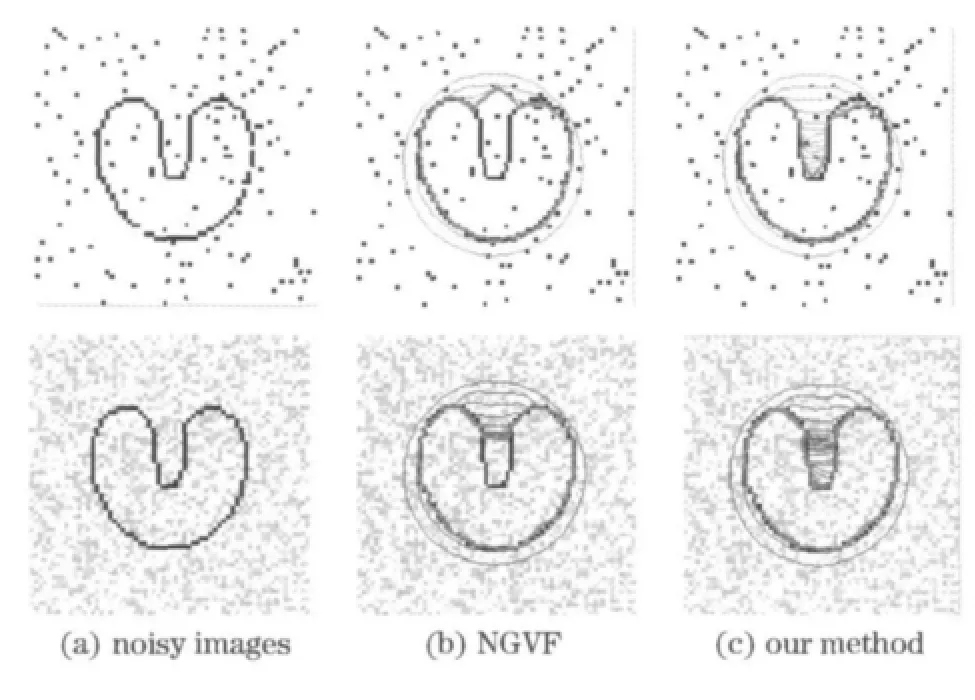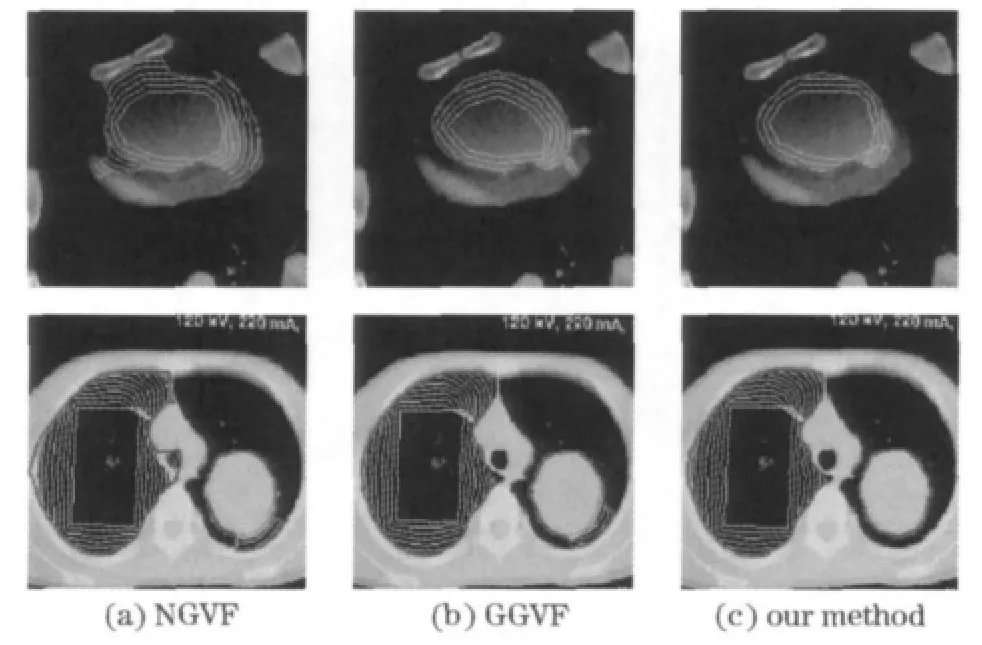Active contours with normally generalized gradient vector flow external force
ZHAO Heng-bo(赵恒博), LIU Li-xiong(刘利雄), ZHANG Qi(张麒),YAO Yu-hua(姚宇华), LIU Bao(刘宝)
(Beijing Key Laboratory of Intelligent Information Technology,School of Computer Science and Technology,Beijing Institute of Technology,Beijing 100081,China)
Active contours or snakes,have been the most influential variational method to image segmentation since their introduction[1],which are curves defined within an image domain that can conform to an object boundary or other desired features within an image under the influence of internal forces and external forces from the image data[1].Generally,active contours can be categorized as parametric snakes[1]or as geometric snakes[2-4]according to their representation.The parametric snakes have explicit representation while geometric snakes are defined implicitly.
Since external force plays a leading role in active contours during evolution,many novel meth-ods for external force are proposed[5-7].Among all the methods,gradient vector flow (GVF)[8]attracts the attention of many researches.The GVF model is one of the most successful external forces,which provides a large capture range and the ability to capture concavities by diffusing the gradient vectors of an edge map generated from the image.Consequently,the GVF field has been widely used and improved in various models.For example,the generalized GVF(GGVF)model can force active contour convergence into long,thin boundary indentations[9]and the NGVF model has faster convergence speed towards the concavity and bigger time step[10]while maintaining other desirable properties of the GVF.
In this paper,we propose a novel external force for active models called normally generalized gradient vector flow (NGGVF).The proposed NGGVF is motivated by Refs.[9-10].As an im-provement to the GVF model,the NGGVF snake has not only a large capture range and ability to capture long,thin concavities,but also faster convergence speed towards the concavity and bigger time step.In addition,the proposed model outperforms the NGVF snake in terms of noise robustness and weak edge preserving while maintaining the desirable properties of the NGVF snake.
1 Background
1.1 GGVF:generalized GVF external force
A snake is mathematically an elastic curvec(s)=[x(s),y(s)],s∈[0,1]defined in the image domain which deforms to minimize the following energy functional[1]:



This can be considered as a force balance equation:

where Fint=αcss(s)-βcssss(s),Fext=-Eext.The internal forceFintkeeps the snake contour to be smooth while the external forceFextattracts the snake to the desired image features.
The typical shortcomings of the external force using the gradient vector of the edge map of a given image include limited capture range and poor convergence to concavities[8].In order to solve these problems,Xu and Prince[8]proposed the gradient vector flow(GVF)model to replace Fext=-ΔEextin Eq.(3).The GVF is a vector fieldV(x,y)=[u(x,y),v(x,y)]obtained by minimizing the following energy functional[11]:

wherefis the edge map of an image,μis a regularization parameter.Functionsu(x,y)andv(x,y)are at leastC2whenEGVFis minimized.The Euler equation to minimizeEGVFreads

where2is the Laplacian operator.

1.2 NGVF:gradient vector flow in the normal direction
The GVF has a close relationship with Laplacian terms.Accordingly,if Laplacian terms in Eq.(5)could be replaced with other better diffusion operator,the property of the GVF force field would be improved[10].In Ref.[12],the Laplacian operator can be decomposed into two terms,takingu(x,y)as an example,

whereuTTanduNNare the second derivatives ofu(x,y)in the tangential and normal directions of the isophotes,respectively.It was pointed out in Ref.[13]that,as an interpolation operator,uNNhas the best performance,and2uthe secondly anduTTthe worst.By taking the diffusion process in Eq.(5)as an interpolation process,the NGVF is proposed using the best interpolator,as follows[10]

whereμis also a positive weight as in Eq.(5).
2 NGGVF snakes
2.1 Analysis of the NGVF external force

Sinceμis a constant,the NGVF model can’t build a close relationship between the smoothness and the edge map of an image.Thusμcan’t automatically change itself according to the edge map of an image.As a result,the NGVF model would be sensitive to noise and could erase weak edges[14].In this situation,the NGVF tends to lose the forces necessary to drive an active contour into the desirable region.
2.2 The proposed NGGVF external force


In Eq.(10),the first term on the right is referred to as the smoothing term since this term alone will produce a smoothly varying vector field,which has a better diffusion effect than the Laplacian term.The second term is referred as the data term since it encourages the vector fieldvto be close tofcomputed from the data.Consequently,the weighting functionsg(·)andh(·)apply to the smoothing and data terms,respectively.
To address the problem of the NGVF,weighting functions can be selected such thatg(·)gets smaller ash(·)becomes larger.Then,in the proximity of large gradients,there will be very little smoothing,and the effective vector field will be nearly equal to the gradient of the edge map.The NGGVF field computed using this pair of weighting functions will conform to the edge map gradient at strong edges,but will vary smoothly away from the boundaries.The specification ofKdetermines to some extent the degree of tradeoff between field smoothness and gradient conformity.
3 Experimental results
Next,we demonstrate some desirable properties of the NGGVF snake and compare the performances of the NGGVF,NGVF and GGVF snakes.Since the NGGVF is an improvement for the NGVF,we focus primarily on some common concerns in snake-based image segmentation on them,which include:①deep and narrow concavity convergence,②weak edge preserving,③noise sensitivity,and④real images.The parameters for all snakes in our experiments areα=0.1,β=0,time stepτ=1.The regularizationμfor the NGVF snakes are identically set to 0.15.The parameterKfor NGGVF and GGVF are set to 0.1in all experiments unless otherwise stated.
3.1 Narrow and deep concavity convergence
It is well-known the GVF snake can converge to U-shape concavity,but when the concavity is very narrow and deep,the GVF snake would fail.Here,we will demonstrate the performance of the NGGVF snake on this issue.Fig.1shows the performance of the NGVF,GGVF and NGGVF snakes on a concavity of 5-pixel width and 40-pixel depth when their force field iteration number is 200.It shows that the NGGVF snake succeeds in converging to this long and thin concavity.Compared with the GGVF model,the NGGVF snake costs much less computation time.Fig.2shows the capture range of the NGVF field is large enough only when the iteration number is above 1 000.

Fig.1 Convergences of the NGVF,GGVF and our method on narrow and deep concavity

Fig.2 The force fields
3.2 Weak edge preserving
As already pointed out in Ref.[6],the diffusion along the normal direction of the isophotes tends to smooth the edges,but this diffusion in the NGVF is maintained and even stressed,this would lead to the fact that the NGVF couldn’t preserve weak edges.Fig.3shows the performance of the NGVF,GGVF and NGGVF snakes on this issue on a synthetic image,where there are a rectangle with weak edge and one strong edge nearby,the spacing between them is just three pixels.It is clear that the NGGVF snake has the best performance among the three peers.The reason behind this result is that the diffusion in the NGVF is too strong on boundaries and that in the NGGVF and GGVF snakes are controlled by the weighting functiong(·).The strategy can help to preserve weak edges.Compared with the GGVF model,the NGGVF has a better operator,so it has a faster convergence speed.

Fig.3 Convergences of the NGVF,GGVF and our method on weak edge preserving
3.3 Noise sensitivity
The U-shape image contaminated by impulse noises is employed to test the performance of the NGGVF on noise sensitivity.The first noisy image in Fig.4is coined by adding“salt &pepper”noise of intensity 0.06and the second one in Fig.4is by“speckle”noise with mean 0and variance 0.02,both of them are smoothed using a Gaussian filter of standard deviation 0.8before calculating the external force.It can be seen that the NGVF snake was attracted by noise,but the proposed NGGVF snake moved into the concavity successfully.

Fig.4 Convergences of the NGVF and our method on noise sensitivity
3.4 Real images
Fig.5shows the segmentation results of the NGVF,GGVF and NGGVF snakes on the real medical images,i.e.,one cardiac CT image(the first row)and one lung CT image (the second row).In these examples,we have to cope with noises and weak edges.For the cardiac image,we aim to extract the endocardium of the left ventricle,which is a weak edge.One can see that the NGVF and GGVF snakes can’t converge into the desirable region on the image.For the lung image,the NGVF and GGVF snakes also leak out at weak edges and get trapped into noise,whereas the NGGVF snake performs well on weak edge preserving and noise resistance.

Fig.5 Convergences of the NGVF,GGVF and our method on the real medical images
4 Conclusion
We propose a novel external force called normally generalized gradient vector flow (NGGVF)for active contours.The NGGVF is a generalization of the NGVF formulation that includes two spatially varying weighting functions,which has a good performance on deep and narrow concavity convergence,weak edge preserving,low noise sensitivity while maintaining other desirable properties of the NGVF,such as faster convergence speed towards the concavity and bigger time step.Experimental results show that the NGGVF snake outperforms the NGVF and GGVF snakes and can act as a superior alternative to the NGVF and GVF snakes.
[1]Kass M,Witkin A,Terzopoulos D.Snakes:active contour models[J].International Journal of Computer Vision,1987,1(4):321-331.
[2]Caselles V,Catte F,Coll T,et al.A geometric model for active contours[J].Numer Math,1993,66:21-31.
[3]Paragios N,Mellina-Gottardo O,Ramesh V.Gradient vector flow fast geometric active contours[J].IEEE Trans Pattern Anal Machine Intell,2004,26(3):402-407.
[4]Shawn Lankton,Allen Tannenbaum.Localizing region based active contours[J].IEEE Trans Image Process,2008,17(11):2029-2039.
[5]Cohen L D.On active contour models and balloons[J].CVGIP:Image Understanding,1991,53:211-218.
[6]Cohen L D,Cohen I.Finite-element methods for active contour models and balloons for 2-D and 3-D images[J].IEEE Trans Pattern Anal Machine Intell,1993,15:1131-1147.
[7]Leroy B,Herlin I,Cohen L D.Multi-resolution algorithms for active contour models[C]∥Int Conf Analysis and Optimization of Systems.Paris:[s.n.],1996:58-65.
[8]Xu C,Prince J.Snakes,shapes and gradient vector flow [J].IEEE Trans Image Process,1998,7(3):359-369.
[9]Xu C,Prince J.Generalized gradient vector flow external forces for active contours[J].Signal Process,1998,71:131-139.
[10]Ning J,Wu C,Liu S,et al.NGVF:an improved external force field for active contour model[J].Pattern Recognit Lett,2007,28:58-63.
[11]Xu C,Prince J.Gradient vector flow:a new external force for snakes[C]∥IEEE Proc Conf on Comput Vis Patt Recog.San Juan,Puerto Rico:Computer Vision and Pattern Recognition,1997:66-71.
[12]You Y,Xu W,Tannenbaum A,et al.Behavioral a-nalysis of anisotropic diffusion in image processing[J].IEEE Trans Image Process,1996,5(11):1539-1552.
[13]Caselles V,Morel J,Sbert C.An axiomatic approach to image interpolation [J].IEEE Trans Image Process,1998,7(3):376-386.
[14]Wang Y,Liu L,Zhang H,et al.Image segmentation using active contours with normally biased GVF external force [J].IEEE Signal Processing Letters,2010,17(10):875-878.
(Edited byWang Yuxia)
 Journal of Beijing Institute of Technology2012年2期
Journal of Beijing Institute of Technology2012年2期
- Journal of Beijing Institute of Technology的其它文章
- Artificial neural network modeling of mechanical properties of armor steel under complex loading conditions
- Optimization of the carrier tracking loop for GPS high dynamic receivers
- Vibration test of micro machined gyroscope based on high speed photography and SURF
- Experimental validation method of elastic thin rod model for simulating the motional cable harness
- Calculation methods of lubricant film pressure distribution of radial grooved thrust bearings
- Development of an occupant restraint system model and parametric study on equivalent crash pulse in vehicle frontal offset crash
